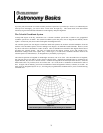
41
After looking at the night sky for a while you may want to try photographing it. Several forms of celestial
photography are possible with your telescope, including short exposure prime focus, eyepiece projection,
long exposure deep sky, terrestrial and even CCD imaging. Each of these is discussed in moderate detail
with enough information to get you started. Topics include the accessories required and some simple
techniques. More information is available in some of the publications listed at the end of this manual.
In addition to the specific accessories required for each type of celestial photography, there is the need for a camera -
but not just any camera. The camera does not have to have many of the features offered on today's state-of-the-art
equipment. For example, you don't need auto focus capability or mirror lock up. Here are the mandatory features a
camera needs for celestial photography. First, a “B” setting which allows for time exposures. This excludes point and
shoot cameras and limits the selection to SLR cameras, the most common type of 35mm camera on the market today.
Second, the “B” or manual setting should NOT run off the battery. Many new electronic cameras use the battery to
keep the shutter open during time exposures. Once the batteries are drained, usually after a few minutes, the shutter
closes, whether you were finished with the exposure or not. Look for a camera that has a manual shutter when
operating in the time exposure mode. Olympus, Nikon, Minolta, Pentax, Canon and others have made such camera
bodies.
The camera must have interchangeable lenses so you can attach it to the telescope and so you can use a variety of
lenses for piggyback photography. If you can't find a new camera, you can purchase a used camera body that is not
100-percent functional. The light meter, for example, does not have to be operational since you will be determining the
exposure length manually.
You also need a cable release with a locking function to hold the shutter open while you do other things. Mechanical
and air release models are available.
Short Exposure Prime Focus Photography
Short exposure prime focus photography is the best way to begin recording celestial objects. It is done with the camera
attached to the telescope without an eyepiece or camera lens in place. To attach your camera you need the Celestron T-
Adapter (#93633-A) and a T-Ring for your specific camera (i.e., Minolta, Nikon, Pentax, etc.). The T-Ring replaces
the 35mm SLR camera's normal lens. Prime focus photography allows you to capture the majority of the lunar disk or
solar disk. To attach your camera to your telescope.
1. Remove all visual accessories.
2. Thread the T-Ring onto the T-Adapter.
3. Mount your camera body onto the T-Ring the same as you would any other lens.
4. Thread the T-Adapter onto the back of the telescope while holding the camera in the desired orientation (either
vertical or horizontal).
With your camera attached to the telescope, you are ready for prime focus photography. Start with an easy object like
the Moon. Here's how to do it:
1. Load your camera with film that has a moderate-to-fast speed (i.e., ISO rating). Faster films are more desirable
when the Moon is a crescent. When the Moon is near full, and at its brightest, slower films are more desirable.
Here
are some film recommendations:
• T-Max 100


















